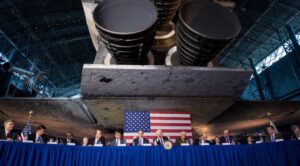Space Council recommendations address exploration and management concerns

CHANTILLY, Va. — Despite a strong public endorsement of NASA’s efforts to return humans to the moon as a step towards Mars, a series of recommendations approved by the National Space Council Aug. 20 highlight concerns about the agency’s plans to do so.
The council, at its sixth public meeting since being reconstituted two years ago, did not discuss the recommendations when presented by Vice President Mike Pence, chair of the council, at the end of the two-hour meeting. Pence, citing schedule constraints, only briefly described the recommendations and asked council members to endorse them. Members did so unanimously and without debate.
The council released the recommendations late Aug. 20, which are primarily in three areas: exploration and international cooperation, commercial space and industrial base issues, and NASA acquisition and workforce reform.
The exploration recommendations include one highlighting uncertainty about the status of the Space Launch System and Orion spacecraft. “At the next Council meeting, the NASA Administrator will present a plan to stabilize the Space Launch System and Orion programs and prevent future cost and schedule overruns,” the recommendation states. “The plan will include the current projected launch windows for the first two launches of these vehicles.”
NASA has not provided an updated schedule for the first SLS/Orion mission, Artemis 1, although contractors involved in the program said at an Aug. 19 conference that they now expect the launch to take place in early 2021, rather than 2020. NASA Administrator Jim Bridenstine has said he wants to wait until a new associate administrator for human exploration and operations, replacing Bill Gerstenmaier, is in place before setting a new formal launch date.
At the meeting, Pence didn’t discuss any concerns about SLS or Orion, saying that NASA’s efforts to return humans to the moon were “on track” and citing milestones in the development of both SLS and Orion. SLS, he noted, “will be fully assembled by the end of this year,” a reference to the completion of the long-delayed core stage of the rocket.
Another recommendation calls on the NASA administrator to “designate an office and submit a plan to the Chairman of the National Space Council for sustainable lunar surface exploration and development, including necessary technologies and capabilities, to enable initial human missions to Mars.”
Pence did offer a new emphasis about the importance of long-duration stays on the moon and learning to use resources there in his remarks. “Unlike a half-century ago, this time our objective will be to establish a permanent presence on the lunar surface, and from there we will develop the capabilities to journey to the Red Planet of Mars,” he said. NASA has provided few details about what kind of long-term lunar presence it will have once it returns to the moon for short-duration stays in 2024.
A separate recommendation called on NASA to work with the State Department on identifying opportunities for international cooperation. “Lunar surface operations will be NASA’s top priority for international cooperation,” it states.
Two other recommendations address how NASA will manage its exploration programs. One requests that, by the next council meeting, NASA work with the Office of Personnel Management and Office of Management and Budget “on the status of workforce modernization efforts to address the barriers in Federal statute, regulations, policies, or practices that impede NASA’s ability to deliver on its critical mission requirements.”
The other asks NASA and the Defense Department to report “on efforts to mitigate, as appropriate, industrial base barriers and constraints, up to and including submission of a DX rating package, consistent with requirements of the Defense Production Act, to accomplish the 2024 human lunar landing mission.” A “DX rating” is used by the Defense Department for programs of the highest national priority, giving them priority in contracting over other programs.
Pence had hinted at changes he sought in how NASA manages programs and personnel in his speech. “We’ll continue to transform NASA into a leaner, more accountable and more agile organization,” he said. “We’re going to make it easier than ever to recruit and retain the world’s brightest scientists, engineers and managers, and we’re going to hit our goals and make new American history in space.”
Several recommendations addressed commercialization issues, including a request for NASA to “report on potential lunar resources to support sustainable lunar activities and science opportunities that could involve commercial partners.” Another recommendation directed the Commerce Department to, within 90 days, examine the health of the commercial space sector and the factors that influence it, “including proposals to strengthen United States commercial space leadership.”
One recommendation tackles a longstanding concern among some commercial space companies about a lack of regulatory authority for so-called “non-traditional” activities, ranging from commercial space stations to lunar landers. Article 6 of the Outer Space Treaty requires countries to provide “authorization and continuing supervision,” but for many commercial space activities no U.S. government agency has that clear responsibility.
The recommendation instructs the Commerce Department to, within 90 days, report on such commercial space activities not regulated by agencies today, and then work with the Department of Transportation to “provide a roadmap to enable all current and evolving United States commercial space activities to receive authorization under appropriate Federal regulatory frameworks.”
One other recommendation, included in the section on commercial space but that will also involve NASA’s exploration activities, calls for the creation of “a Moon-Mars Development Strategy that includes low-Earth orbit commercialization, robotic and human exploration, national security capabilities, and international cooperation for science, safety, security, and economic growth.” That plan will be developed by the National Space Council staff and be completed within 180 days.
While many of the recommendations approved at the Aug. 20 meeting request action at the next council meeting, that meeting has not been scheduled. Previous council meetings have taken place every four to five months.
from SpaceNews.com https://ift.tt/2ZkV5QV
Comments
Post a Comment